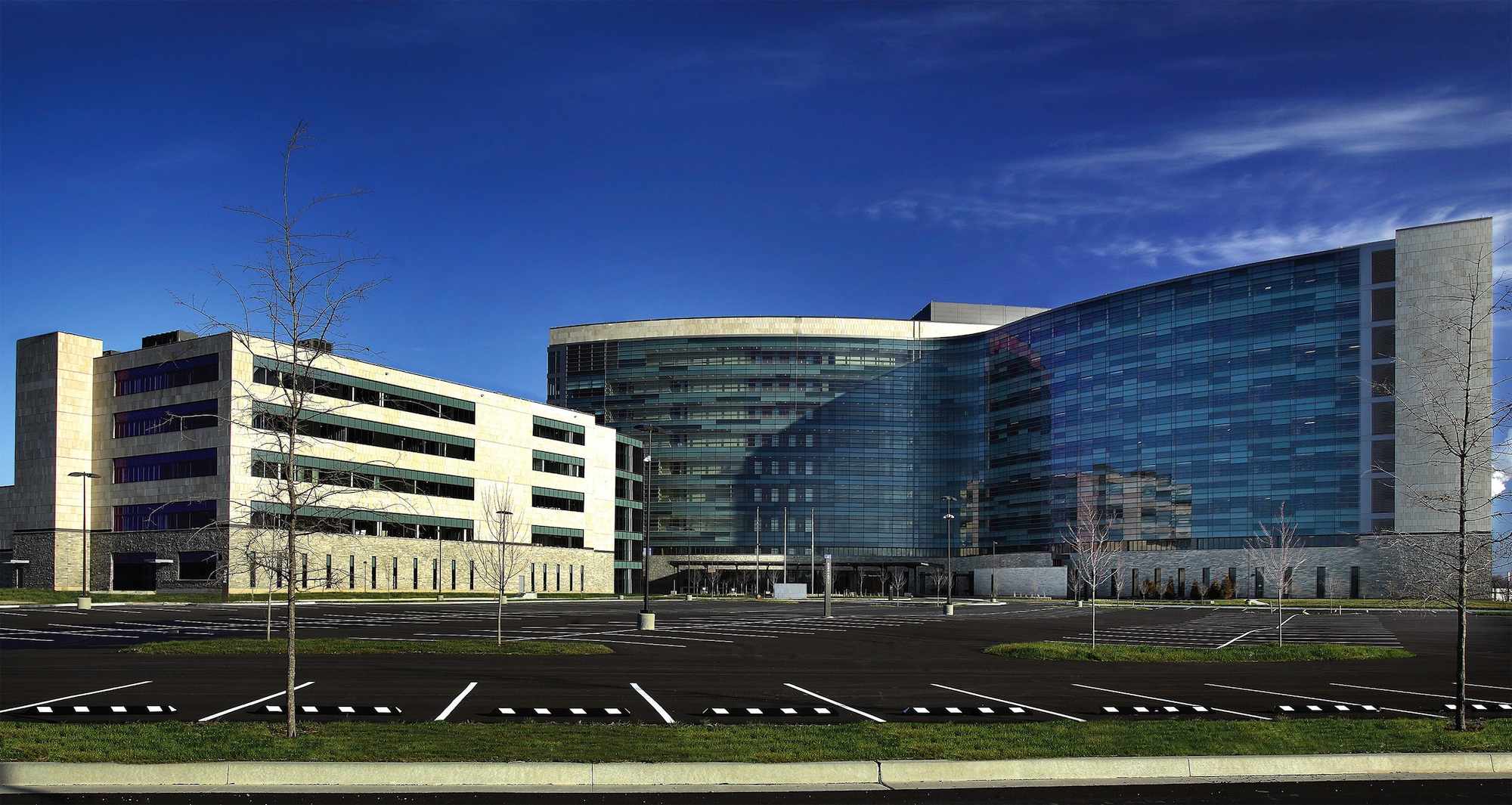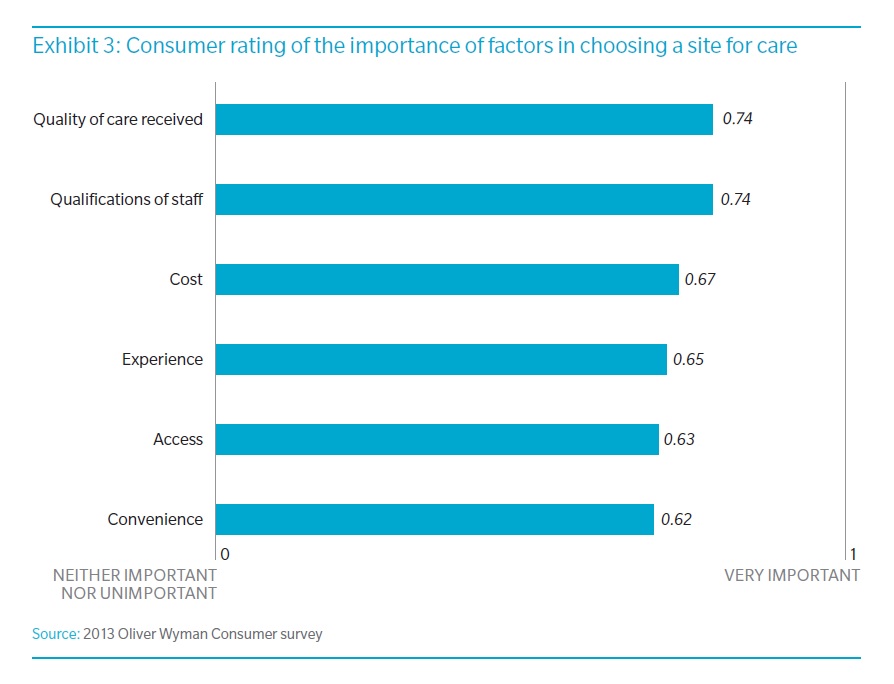By mid-year 2014 approximately $2.3 billion of venture funding for digital health had been placed, surpassing the total investment made in all of 2013. This is yet another statistic that demonstrates an evolving healthcare ecosystem where reform is creating disruptive forces that alter the impact and importance of the players involved.
With changing business practices and a greater emphasis on consumerism, healthcare organizations are looking across their enterprises for answers. Facilities are not escaping the drag net and we continue to see evolving trends that will define the market for real estate and facilities services in 2015 and beyond. The three areas of change we will explore are new products, delivery models, and relationships.
NEW PRODUCTS
With consumers funding more and more of their healthcare services out of pocket, they are becoming more selective in who they seek healthcare services from. In a 2013 survey of healthcare consumers conducted by Oliver Wyman, consumers responded that their top reason for choosing a particular healthcare services location was the quality of care received. Consumers will be focused on every interaction they have with a healthcare provider to rate quality of care from setting up their appointments to the results they experience during and after their visit. The concept of “service” will become a focus of providers that will be successful in 2015 and beyond.
As healthcare organizations plan new facilities and evaluate their overall real estate portfolio, they will continue to look towards facilities that support a first class experience. Not only will they be concerned with the consumer experience, but employee satisfaction will also play a major role. The continued growth of retail care in a healthcare organizations real estate portfolio will continue to be a focus in 2015 and beyond. We will likely see more unique mixed-use projects that carry the live, work and play theme as healthcare focuses on prevention rather than episodic care.
DELIVERY MODELS
As healthcare organizations change their business practices across the enterprise, they are also looking to change the way facilities are delivered and managed. Integrated project delivery models are being requested on a more frequent basis. Many companies that used to market to healthcare organizations as design-build firms have altered their messaging to include the term “integrated.” Healthcare organizations continue to adopt performance improvement models such as Lean to improve their business and integrated project delivery is a natural fit for that culture.
The shift towards an integrated model of delivery is not just project by project based but portfolio based as well.
Healthcare organizations are beginning to see the value of reviewing their entire portfolio and determining the highest and best use for each asset with an understanding of the role it can play in a highly distributed service model. This has increased the demand for strategic real estate planning services that are more holistic than we have seen in the past.
There is a growing desire to develop key performance indicators (KPIs) that take into account clinical outcomes, service line financial performance, building performance and space utilization among other points. Analytical models will be developed in the future that provide an accepted rating system and allow healthcare organizations to measure the true performance of their real estate assets across the ecosystem.
RELATIONSHIPS
New products and an emphasis on new delivery models create new relationships. As healthcare organizations seek more opportunities to save in the delivery and care of facilities, they continue to demand more from group purchasing organizations (GPOs). In the past, GPOs have been focused on medical equipment and other essential supplies necessary to deliver care.
As healthcare organizations expand their net for savings opportunities, they are requesting volume pricing on construction materials, building systems and service contracts. With a limited amount of GPO coverage within this sector, healthcare organizations are exploring direct relationships with key suppliers in an effort to drive prices and increase schedule efficiencies by having more direct control over supply chains.
With an emphasis on ambulatory and retail building products, speed to market becomes more important and, therefore, better predictability with respect to schedule and budget. This has created a demand for roll-out strategies that can deliver portfolios rather than single projects. Healthcare organizations are seeking qualified integrated teams to deliver a solution including the ability to finance, design, build and maintain.
The relationship model continues to shift to a group of preferred providers that are in tune with the organization’s overall strategy and understand their culture and decision making style. In an industry with plenty of chaos, seeking solutions that provide a more predictable outcome will be a focus for healthcare organizations in 2015 and beyond.
CONCLUSION
Healthcare continues to shift toward Madison Avenue and Silicon Valley as it revamps business practices to focus on consumerism and efficiency. Not only does this impact the actual delivery of services, but it continues to have a large effect on the location and type of facility in which those services are delivered. In the next year, expect to see the following:
• Product. A continued emphasis on Ambulatory and Retail facilities and increased development of population health management tools such as wellness centers, adult daycare centers, and virtual medicine hubs.
• Delivery. Continued alignment in the delivery and care of facilities with a culture of improvement. An increase in integrated project delivery and risk sharing models based on short and long term outcomes. Development of holistic analytical models for evaluating portfolio performance.
• Relationships. A change in the relationship between Suppliers, GPOs and healthcare organizations that provides more direct access to innovations without delays and surcharges.
For service providers in the real estate, design and construction industry it will be important to understand how exactly how the healthcare industry is evolving. With shifting payment models and an emphasis on value creation, healthcare organizations will be open to partners that are able to contribute to achieving their strategic goals and not just deliver on a transaction.
The more a firm can demonstrate a predictable outcome that delivers results, the quicker they will become a trusted and preferred partner well into the future.
Related Stories
| Aug 11, 2010
Burt Hill, HOK top BD+C's ranking of the nation's 100 largest university design firms
A ranking of the Top 100 University Design Firms based on Building Design+Construction's 2009 Giants 300 survey. For more Giants 300 rankings, visit http://www.BDCnetwork.com/Giants
| Aug 11, 2010
PBK, DLR Group among nation's largest K-12 school design firms, according to BD+C's Giants 300 report
A ranking of the Top 75 K-12 School Design Firms based on Building Design+Construction's 2009 Giants 300 survey. For more Giants 300 rankings, visit http://www.BDCnetwork.com/Giants
| Aug 11, 2010
Turner Building Cost Index dips nearly 4% in second quarter 2009
Turner Construction Company announced that the second quarter 2009 Turner Building Cost Index, which measures nonresidential building construction costs in the U.S., has decreased 3.35% from the first quarter 2009 and is 8.92% lower than its peak in the second quarter of 2008. The Turner Building Cost Index number for second quarter 2009 is 837.
| Aug 11, 2010
AGC unveils comprehensive plan to revive the construction industry
The Associated General Contractors of America unveiled a new plan today designed to revive the nation’s construction industry. The plan, “Build Now for the Future: A Blueprint for Economic Growth,” is designed to reverse predictions that construction activity will continue to shrink through 2010, crippling broader economic growth.
| Aug 11, 2010
New AIA report on embassies: integrate security and design excellence
The American Institute of Architects (AIA) released a new report to help the State Department design and build 21st Century embassies.
| Aug 11, 2010
Section Eight Design wins 2009 Open Architecture Challenge for classroom design
Victor, Idaho-based Section Eight Design beat out seven other finalists to win the 2009 Open Architecture Challenge: Classroom, spearheaded by the Open Architecture Network. Section Eight partnered with Teton Valley Community School (TVCS) in Victor to design the classroom of the future. Currently based out of a remodeled house, students at Teton Valley Community School are now one step closer to getting a real classroom.








